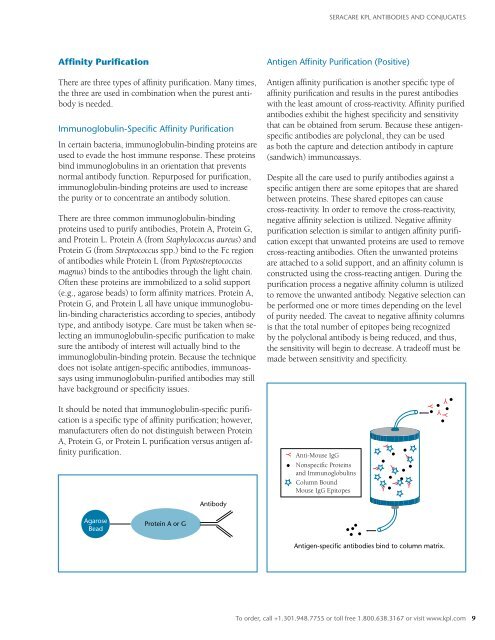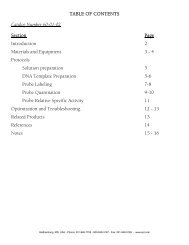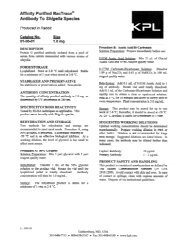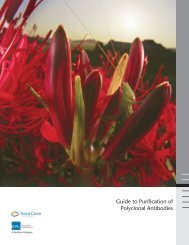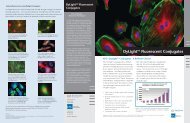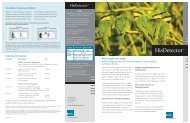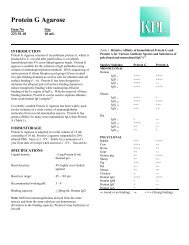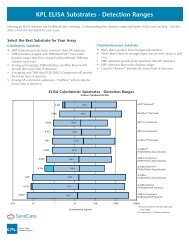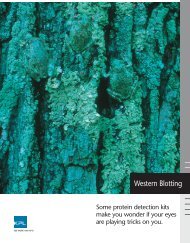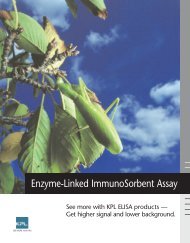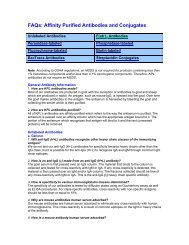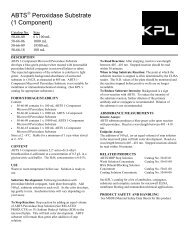KPL Antibodies and Conjugates Catalog
KPL Antibodies and Conjugates Catalog
KPL Antibodies and Conjugates Catalog
Create successful ePaper yourself
Turn your PDF publications into a flip-book with our unique Google optimized e-Paper software.
SERACARE <strong>KPL</strong> ANTIBODIES AND CONJUGATESAffinity PurificationThere are three types of affinity purification. Many times,the three are used in combination when the purest antibodyis needed.Immunoglobulin-Specific Affinity PurificationIn certain bacteria, immunoglobulin-binding proteins areused to evade the host immune response. These proteinsbind immunoglobulins in an orientation that preventsnormal antibody function. Repurposed for purification,immunoglobulin-binding proteins are used to increasethe purity or to concentrate an antibody solution.There are three common immunoglobulin-bindingproteins used to purify antibodies, Protein A, Protein G,<strong>and</strong> Protein L. Protein A (from Staphylococcus aureus) <strong>and</strong>Protein G (from Streptococcus spp.) bind to the Fc regionof antibodies while Protein L (from Peptostreptococcusmagnus) binds to the antibodies through the light chain.Often these proteins are immobilized to a solid support(e.g., agarose beads) to form affinity matrices. Protein A,Protein G, <strong>and</strong> Protein L all have unique immunoglobulin-bindingcharacteristics according to species, antibodytype, <strong>and</strong> antibody isotype. Care must be taken when selectingan immunoglobulin-specific purification to makesure the antibody of interest will actually bind to theimmunoglobulin-binding protein. Because the techniquedoes not isolate antigen-specific antibodies, immunoassaysusing immunoglobulin-purified antibodies may stillhave background or specificity issues.Antigen Affinity Purification (Positive)Antigen affinity purification is another specific type ofaffinity purification <strong>and</strong> results in the purest antibodieswith the least amount of cross-reactivity. Affinity purifiedantibodies exhibit the highest specificity <strong>and</strong> sensitivitythat can be obtained from serum. Because these antigenspecificantibodies are polyclonal, they can be usedas both the capture <strong>and</strong> detection antibody in capture(s<strong>and</strong>wich) immunoassays.Despite all the care used to purify antibodies against aspecific antigen there are some epitopes that are sharedbetween proteins. These shared epitopes can causecross-reactivity. In order to remove the cross-reactivity,negative affinity selection is utilized. Negative affinitypurification selection is similar to antigen affinity purificationexcept that unwanted proteins are used to removecross-reacting antibodies. Often the unwanted proteinsare attached to a solid support, <strong>and</strong> an affinity column isconstructed using the cross-reacting antigen. During thepurification process a negative affinity column is utilizedto remove the unwanted antibody. Negative selection canbe performed one or more times depending on the levelof purity needed. The caveat to negative affinity columnsis that the total number of epitopes being recognizedby the polyclonal antibody is being reduced, <strong>and</strong> thus,the sensitivity will begin to decrease. A tradeoff must bemade between sensitivity <strong>and</strong> specificity.It should be noted that immunoglobulin-specific purificationis a specific type of affinity purification; however,manufacturers often do not distinguish between ProteinA, Protein G, or Protein L purification versus antigen affinitypurification.YAnti-Mouse IgGNonspecific Proteins<strong>and</strong> ImmunoglobulinsColumn BoundMouse IgG EpitopesYYYY YYYYYYYAntibodyAgaroseBeadProtein A or GAntigen-specific antibodies bind to column matrix.To order, call +1.301.948.7755 or toll free 1.800.638.3167 or visit www.kpl.com9


